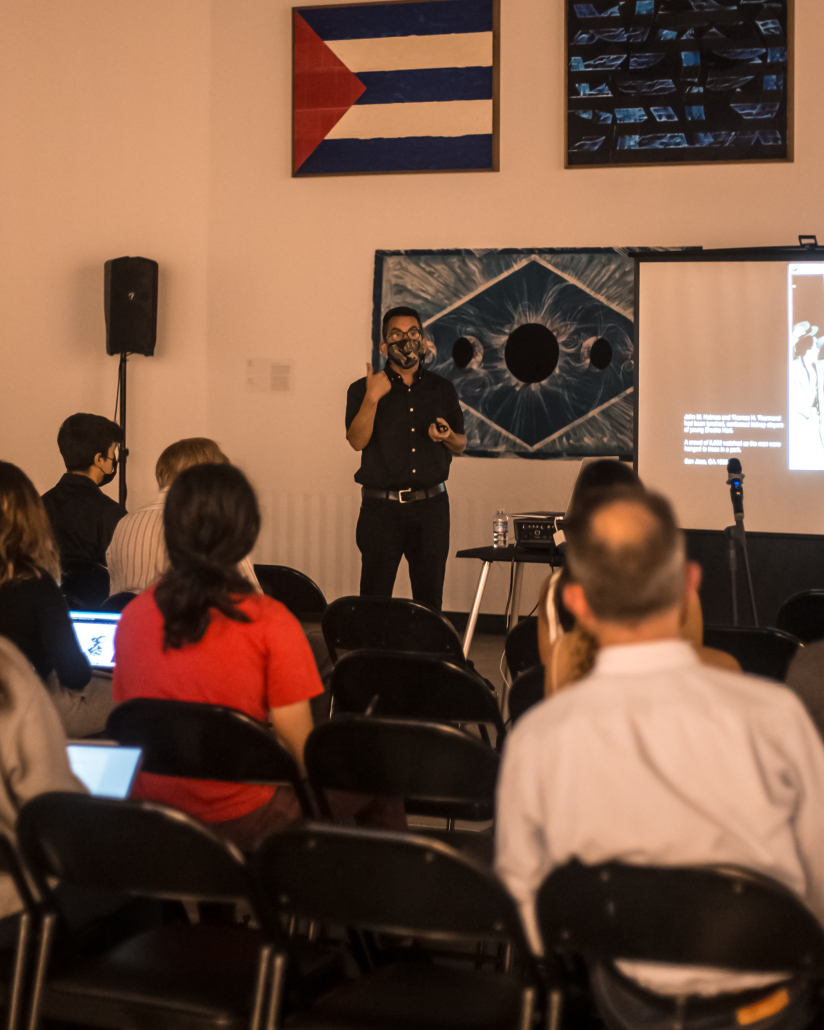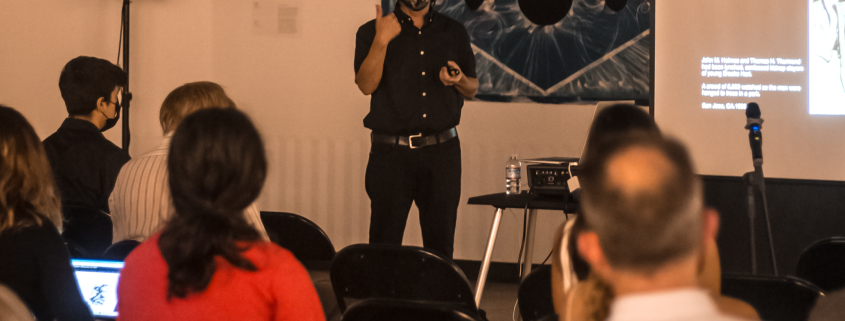Artist discusses ‘Erased Lynching’ photo series

Los Angeles-based artist Ken Gonzales-Day discussed his ongoing series, “Erased Lynching,” Thursday at the USC Fisher Museum of Art. Invited as part of the museum’s Fall 2021 exhibition “Art and hope at the end of the Tunnel,” Gonzales-Day talked about the history of lynching’s erasure in California, particularly of Latinx people.
Comparing the crowds from the Jan. 6 Capitol Hill riot to the crowds of people in photographs of lynchings, Gonzales-Day focused on the prevalence of racially motivated violence to date.
“I was surprised that we hadn’t evolved or changed in basically 100 years, and that there’s still that sense of excitement and hurting people and public acts of violence that are, if not directly racially motivated, at least racially informed,” Gonzales-Day said.
The “Erased Lynching” exhibition presents historic photographs taken at lynchings, which have been digitally altered by Gonzales-Day to remove the victim and the rope, guiding the viewer to focus on the crowd in the image. The technique is used to make spectators think about the racial undertones of the act. The photographs came from diverse sources, such as postcards, newspapers and archived images.
Removing the victims from the photographs was important, not only to refocus the images, but also to avoid revictimizing the victims, Gonzales-Day said.
“You can kill somebody only once, but if you want to make it a lasting thing for them, take a picture of it so you continue to inflict pain,” Gonzales-Day said.
Gonzales-Day started his research for this project around 20 years ago by reading different California newspapers from 1849 to 1879. But because of the newspapers’ age and the unclear nature of records, his research proved to be a challenge. Nonetheless, the series now includes more than 60 images, and Gonzales-Day does not plan to stop his research.
As a Mexican American, Gonzales-Day said the project allowed him to reflect on the xenophobia he experienced growing up. It made him realize that it was not his fault but a systemic problem that is more than a hundred years old.
“You’re used to being called names and being treated differently growing up. I always felt bad about that and never understood why or how that was happening. I felt like it was my fault,” Gonzales-Day said. “The project helped me to work through that and realize, ‘No, this isn’t my fault. We’ve been here a long time. We were part of the country. We helped build the country.’”
Gonzales-Day also developed a self-guided walking tour of the lynching locations in downtown Los Angeles. However, he was able to identify locations throughout the entire state. This was surprising for Claire Smerdan, a sophomore majoring in computer science and business who attended the event.
“I grew up in the Bay Area, and to see these lynchings happen in places that I know really well was very disturbing,” Smerdan said.
Additionally, by focusing on the Latinx demographic, the event provided a perspective unknown to some attendees, such as Jessica Stacey, a sophomore majoring in philosophy, politics and law who attended the event.
“I didn’t actually know much about Latinos being lynched, so I think it was super important and definitely a very informative way to bring these pictures to life by removing the bodies and focusing on the people involved,’’ Stacey said.
The event also allowed attendees to consider the importance of learning about the different acts of violence that have been committed throughout history. For Smerdan, this helped her reflect on the importance of events like this one.
“I think it’s really important to learn about history because these events still influence our current time, as well when you study history … it helps us prevent them from happening again in the future,” Smerdan said.

